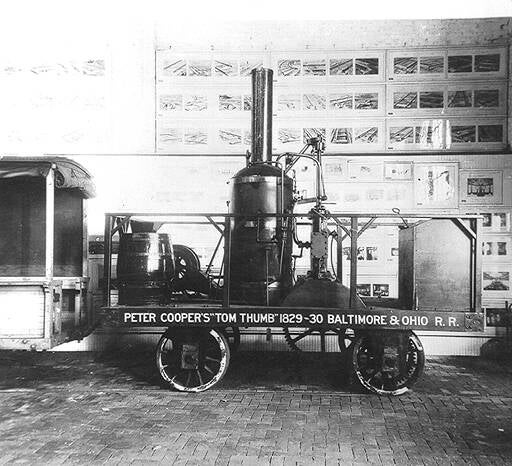A working replica of Robert Stephenson's 1830 locomotive Planet which ran on the Liverpool and Manchester Railway, UK.
(G-Man, Public domain, via Wikimedia Commons)
2-2-0 PLANET WHEEL ARRANGEMENT
Under the Whyte notation for the classification of steam locomotives, 2-2-0 represents the wheel arrangement of two leading wheels on one axle, two powered driving wheels on one axle, and no trailing wheels. This configuration, which became very popular during the 1830s, was commonly called the Planet type after the first locomotive, Robert Stephenson's Planet of 1830.
The 2-2-0 featured two leading wheels on one axle, two powered driving wheels on one axle, and no trailing wheels. Front of locomotive on left.
(Gwernol, Public domain, via Wikimedia Commons)
A replica of the Tom Thumb, the first American-built locomotive designed by Peter Cooper, shown in 1927.
(E. T. Kenney, Public domain, via Wikimedia Commons)
Use in North America
Tom Thumb, the first American-built steam locomotive used on a common-carrier railroad, built by Peter Cooper in 1830 was a gear-driven 2-2-0, but the type was not perpetuated. It also differed in the fact that the driving wheels and leading wheels were of the same diameter, as seen in the above photo.
Decline of the 2-2-0
By 1840 the 2-2-0 tender type had largely been superseded by the 2-2-2 configuration. However, there are a few examples of later tank engines, thus William Bridges Adams of the Fairfield Locomotive Works in Bow supplied a 2-2-0 well tank to the Roman Railway in 1850. Also Dugald Drummond of the London and South Western Railway introduced his C14 class 2-2-0T in 1906, for Auto trains, but this design was not successful and several of the locomotives were rebuilt to 0-4-0.
2-2-0 (Planet) Overview
Equivalent classifications
- UIC class: 1A
- French class: 110
- Turkish class: 12
- Swiss class: 1/2
- Russian class: 1-1-0
Drawbacks: Poor adhesion without coupled wheels





